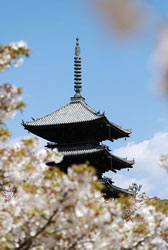Ninna-ji is one of Kyoto's most interesting temples, featuring a large variety of different buildings and gardens on its spacious grounds. It belongs to Kyoto's UNESCO world heritage sites.

History
It is the main temple of the Omuro School of the Shingon sect. Founded on the orders of Emperor Koko and completed in 888. Emperor Uda became the first abbot of the temple when he retired. His residence was known as Omuro Palace.
From then until the Meiji Restoration in 1868 the position of head priest was always taken by a member of the imperial family. Many of the buildings and subordinate temples were lost during the Onin War (1467-1477) and the oldest buildings standing today date from the early 17th century.
The buildings of Uda's era have long been destroyed by some of the many fires that ravaged the site. The Omuro-gosho, a palace-like structure at the southwest corner of the temple is said to be the site of the original temple. Time passed and slowly the temple evolved into a shinden-style estate where the head priest lived in surroundings reminiscent of the Heian-era mansions of the 11th century. It was carefully renovated in the early 20th century with a lot of attention being paid to keep the “olden days” feeling alive.
Ninnaji Temple has many National Treasures and priceless cultural artifacts in its treasure house. In December 1994 the temple was registered as part of the World Cultural Heritage.
What to see
Among the numerous buildings on the temple grounds, are elegant palace style buildings surrounded by beautiful Japanese gardens, a five storied pagoda, various temple halls, a massive entrance gate, bell tower and tea houses.
Ninna-ji is also famous for a rare, locally cultivated type of cherry tree, named Omuro Cherry. Many Omuro cherry trees, whose blossoms open relatively late during the hanami season, stand on the temple grounds and attract many spectators.
Address
33 O-uchi, Omuro, Ukyo-ku, Kyoto City.
Tel: 075-461-1155, Fax: 075-464-4070



